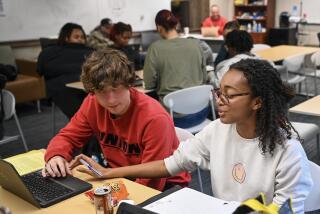Computers Can’t Replace Teachers
- Share via
Computers can be great teaching aids, but they can never replace great teachers. And those teachers are not always the ones leading lectures. That should be the lesson learned from a recent experiment by a Cal State Northridge sociology professor. Last fall, Jerald G. Schutte split his social statistics class into two sections. Half sat through traditional lectures and half were assigned to take the class on computer via the Internet. The result: The half using computers outscored the others by 20 percentage points.
Schutte and others admit that the disparity probably has less to do with the computers than with the fact that students taking the course online were forced to band together and figure out solutions cooperatively. The study comes as Gov. Pete Wilson and the California State University system are considering whether to build an entire campus in cyberspace. But neither Wilson nor the Cal State trustees ought to read too much into Schutte’s research, which proves more about the old notion of cooperative learning than the current rage over computerized instruction.
Good teachers have long known that a group of motivated students can grasp complex concepts better by working together than by sitting in a lecture hall scribbling down every word of an instructor. It’s how effective workers are expected to solve problems on the job. The idea is put to work in schools all over the country. At UCLA’s Anderson Graduate School of Management, for instance, students are assigned working teams to analyze case studies and solve complex quantitative problems. While that curriculum also relies on computers, the focus remains on in-class interaction with and guidance from instructors.
A true university experience demands that students learn from each other as well as from their professors. That’s the very notion of the academy. But pressure from work and other responsibilities forces most students to miss opportunities to discuss and share learning with their fellows. Schutte’s research highlights just how rewarding such interaction can be: Students learn and apply the material rather than just memorize and regurgitate it. It wasn’t the processing power of the computer that made that experience possible. It was the shared knowledge of the group.
Yet without a classroom component, this sort of learning remains only half the experience. Without a properly trained instructor to lead the learning, it runs the risk of going off course. E-mail missives and chat-room get-togethers can never match face-to-face discussions guided by an informed and thoughtful professor. The lesson from Schutte’s research is clear and has little to do with the computer: Students need to challenge each other more.
More to Read
Sign up for Essential California
The most important California stories and recommendations in your inbox every morning.
You may occasionally receive promotional content from the Los Angeles Times.










